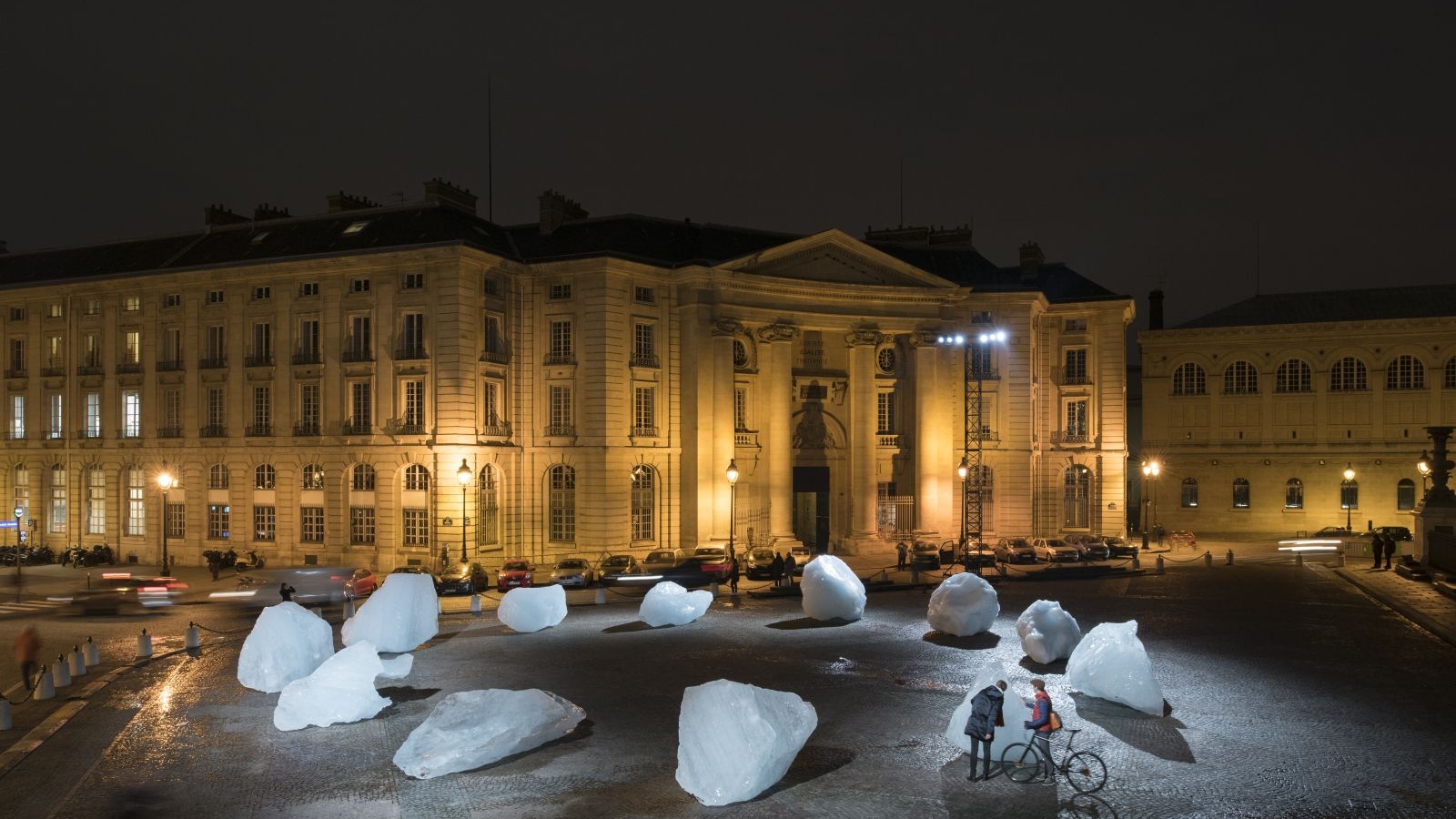By Laurel Jarombek
Ice Watch, an installation art project by artist Olafur Eliasson and professor of geology Minik Thorleif Rosing, opened in Paris at Place du Panthéon on Dec. 3. As World Policy Journal previewed last month, Ice Watch comprises twelve pieces of glacier ice from off the coast of Nuuk, Greenland, weighing 80 metric tons (88 U.S. tons) altogether, arranged in a clock-like formation. The installation will remain in the square for the duration of the Paris Peace Conference, or COP21, serving as a visual reminder of the effects of global warming.
World Policy Journal asked Rosing a few questions about the intersections between science and art and the impact he hopes the piece will have as world leaders deliberate a climate agreement.
WORLD POLICY JOURNAL: The collaboration between you, a professor of geology, and Olafur Eliasson, an artist, at first appears to be an unlikely pairing. What can art projects such as Ice Watch add to your work as a scientist, and how can science be used to inform art?
MINIK THORLEIF ROSING: Olafur and I have often talked about the similarity in the goals of art and science. Both try to analyze and understand our world and our own role in it, and attempt to communicate our findings to the public.
It is my belief that science is very good at giving answers, but not so good at posing questions. Science can help us achieve some goals, but is often very bad at inspiring us to formulate goals. Science is verbal and cerebral, while art is more often emotional, visual, and tactile. I once did an analysis of the forces of the main powers operating on our planet today—geological, biological, etc.—and it turns out that the power of human imagination is one of the most transformative powers on the planet. We can only change the direction and rate of change of our natural environments by activating imagination, and we need to use artistic means of communication to do that.
WPJ: What impact do you hope Ice Watch will have on the climate conference?
MTR: I hope several things. Mostly, I hope that it makes people ponder. Makes it clear that there is a physical reality that one cannot argue away, and that we have to observe and act upon. I also hope it makes people engaged in nature in a positive way. People are touched—often happy—when they touch, listen to, smell, taste, and feel the icebergs. I think it is important that our actions regarding climate change are driven by things we wish to obtain rather than things we deprive ourselves of. Icebergs are beautiful and we cannot afford to lose them from our world. And people who wish to counter climate change are not necessarily driven by fear, parsimony, and dread, but by beauty, fun, and splendor.
WPJ: This is now the second time you and Eliasson have set up Ice Watch. Do you have any plans to continue the project, particularly if world leaders fail to reach a comprehensive agreement on combating climate change at this conference?
MTR: We have no concrete plans—but I think providing people the opportunity to meet a real live iceberg has been very satisfying, and I would not be surprised if we do it again.
*****
As Rosing emphasizes, the tactile element of Ice Watch is crucial to the way the public interacts with the piece. Global warming is often thought of as an imperceptible phenomenon, particularly for people who do not live in environments where rising seas or melting ice directly affect their daily lives. Putting glacial ice in the center of Paris allows passersby to touch the ice and to watch the size of the chunks slowly diminish each day. As Maria Thomas, a student who lives near Place du Panthéon, comments, “It’s so stark to see it melting in front of your eyes.”
Alicia Tam Wei, an American visiting Paris while her husband participates in the COP21 negotiations, adds, “I’m loving it. I think it really makes us think literally about the melting and the warming of the earth. I think it’s so appropriate. I wish [the negotiators] could come see it.”
A common immediate reaction to Ice Watch is surprise at seeing large pieces of glaciers in the middle of the city, but those who linger in the square to fully take in the experience are often inclined to touch or lean against the ice. As Eliasson and Rosing hoped, people walking by are drawn to the ice and are establishing a physical connection with it—and, with any luck, are contemplating the project’s message about climate change in the process.
The questions that remain are whether experiencing Ice Watch will translate to a more activist approach to combating climate change, and how far the project’s effects can spread. Watching streams of water running across the square can certainly provide a powerful image, and witnessing the slow disappearance of the blocks of glacial ice can give people a more tangible idea of what is at stake in the climate negotiations. As Rosing says, art can touch the senses in a way that scientific facts cannot, but the urgency expressed in the installation will need to extend beyond just those who come across it in Place du Panthéon. Ice Watch is in part a message to negotiators at COP21, letting them know that the clock is ticking when it comes to global warming, but this point is likely driven home most strongly through in-person interactions with the ice. The more people get the chance lean their heads against a glacier, the better.
*****
*****
The above interview has been edited and condensed for clarity.
Laurel Jarombek is an editorial assistant at World Policy Journal. Nellie Peyton, a writer based in Paris, assisted with reporting.
[Photos courtesy of Studio Olafur Eliasson and Nellie Peyton]








